Going far? Go together.
9/27/2025
Hello from San Francisco!
Last time, I shared some early designs as well as the decision to use sand as the mechanism to track time. Today I’m excited to share some stories about creative collaboration as well as a video of the first functional prototype.
Let’s get into it!

Going far
From the get-go I’ve looked forward to the day when Superbloom would be more than just a solitary design practice– a time when Superbloom would serve as a vehicle for joyful, creative collaborations– a flourishing ecosystem of enthusiastic individuals from all sorts of disciplines.
Last year, I tried to force this future into being. I’d get coffee with people and wonder, could this person be the collaborator I’ve been looking for?? But as I’ve learned over and over again in this life, forcing and scheming don't work all that well for me.
What does work looks a bit more like this:
- Get clear on my longing, usually by journaling.
- Hone my attention. Daily meditation, good sleep, good food, and exercise all help with this.
- Let the infinite creativity of the universe do the heavy lifting.
- Say “yes” at the right moment (The Greeks called this Kairos).
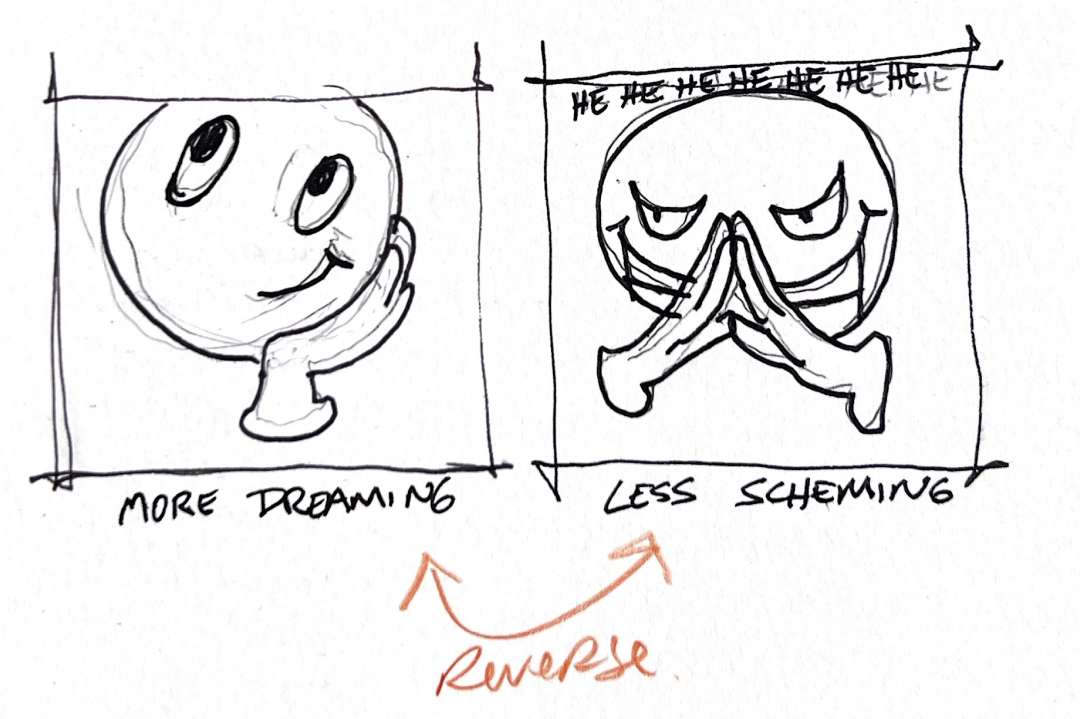
Notes to self, from my sketchbook at the time.
At some point during this period, I found another piece of advice on finding community. It went something like this:
“Want to find folks to run with? It’s easy. Just start running. Run consistently. Do this long enough and you’ll find your people without trying.”
I remember my initial reaction. Uh, couldn’t you just join a run club?
But I get what they're saying. There are niche activities, like designing an analog meditation timer, that lack dedicated clubs (shocker!). In these situations, the best way to find your people is to just start doing the damn thing, share your work as you go, and see who starts running with you, so to speak.
Here's how that happened with the meditation timer and how that led to the first working prototype.
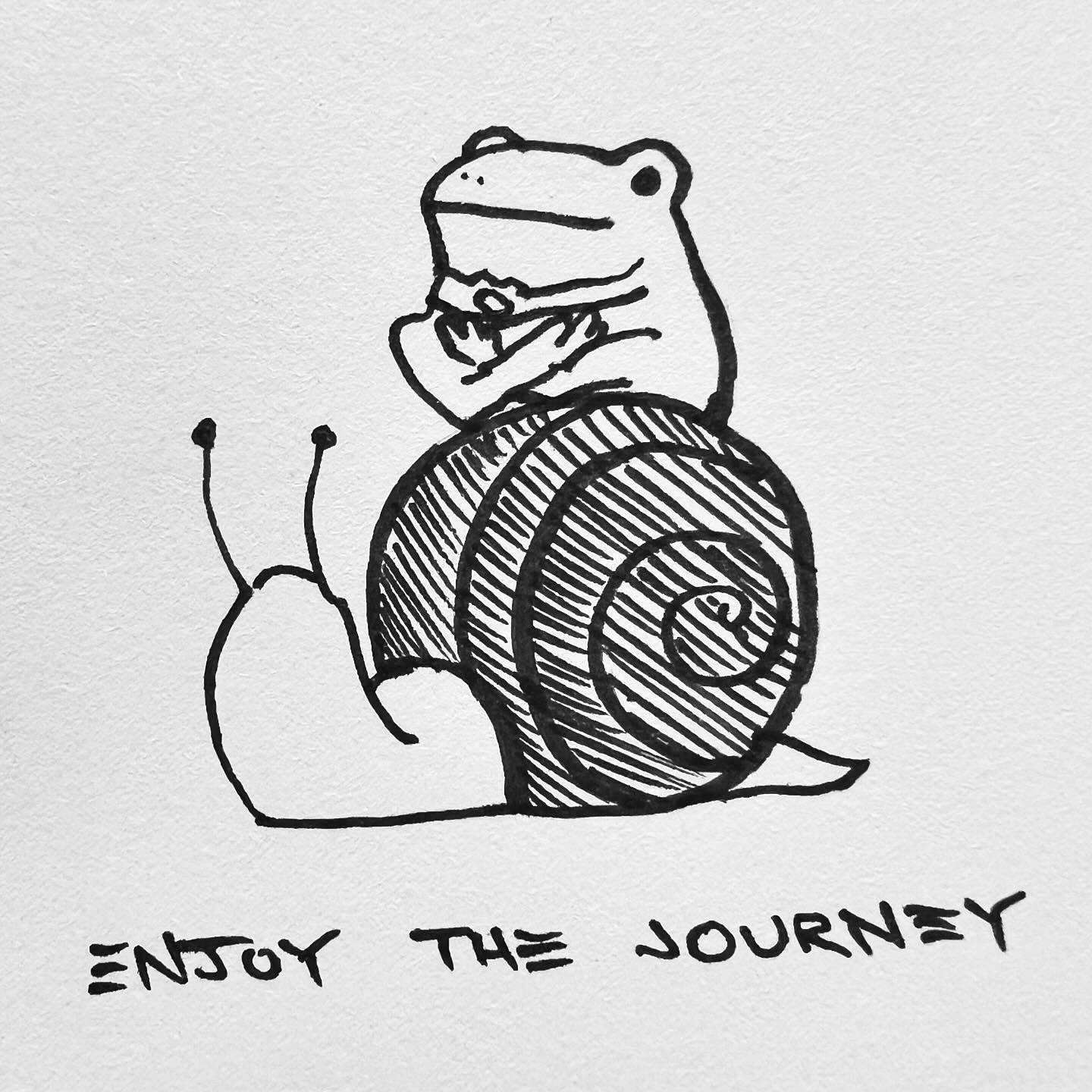
Another note to self. It's all too easy for me to get hooked on an imaginary destination and forget: the journey is all that exists!
Evangelizing
After I’d decided to make the timer analog, I proceeded to absolutely stuff my sketchbooks with diagrams and drawings trying to figure out the mechanics, the aesthetics, the holistic puzzle of this project.
In my enthusiasm, I found myself talking to pretty much everyone I knew about the timer. Heck, I was talking to random strangers about it if they seemed interested! It was a blast. There is truly nothing like working on something you really care about, something that makes you come alive. Enthusiasm is a peerless fuel.
Last November, as the hazy golden afternoons of San Francisco's autumn slipped towards the early nights of winter, I found myself at a party to celebrate the opening of a friend’s new studio space. Sitting around the large communal table, sketching and eating homemade pizza, I showed one of the other folks there, a designer named Brandt, some of my sketches.
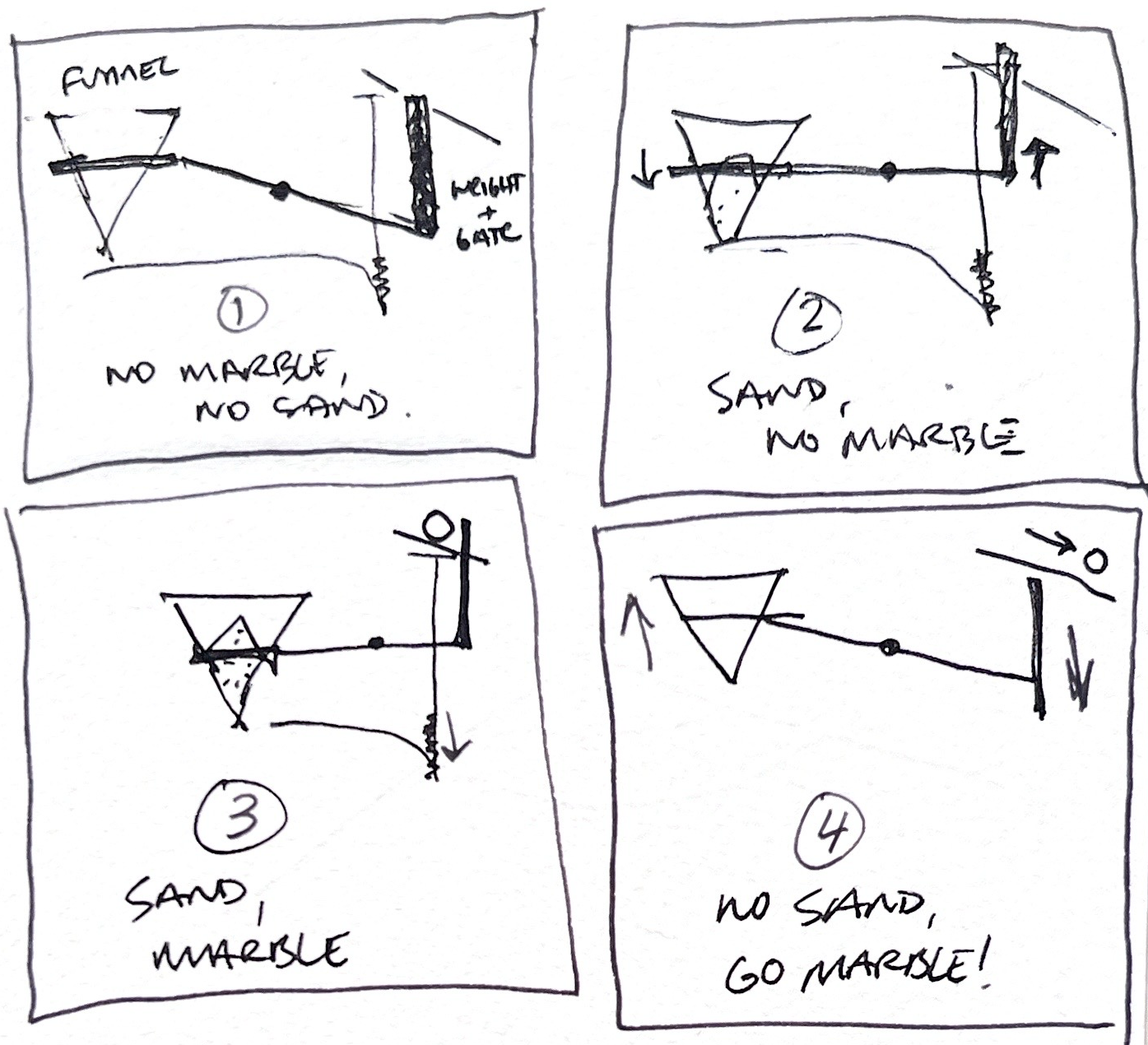
Design for a mechanism that would release a marble when sand had completely drained from a funnel. The funnel sits on a seesaw, opposite a gate just a bit heavier in weight. When the funnel is full of sand, the gate is raised. When emptied, the lack of weight (i.e. sand) would drop the gate, releasing the marble.
So Brandt sees these and says to me, “Dude, I’ve gotta introduce you to my buddy Kyle. He’s a mechanical engineer who’s obsessed with time keeping devices.”
Ding! A tuning fork moment. Kairos. No effort needed besides a "yes".
A few weeks later, Brandt, Kyle, and I met up for our first jam sesh. Like any ecosystem, the plurality of ideas that sprouted from that session were richer and more exciting than anything from my months of monocultural output.
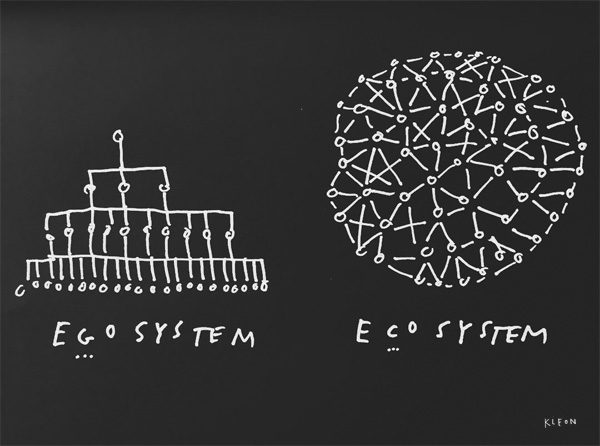
In that session, we converged on a direction:
- We’d use sand to track the progress of time.
- We wouldn’t contain the sand.
- We’d use a fixed amount of sand.
- To set the time, we’d add an aperture at the pinch point of the funnel.
- Tightening the aperture would lead to a slower flow and thus a longer duration.
- Conversely, opening the aperture would lead to a faster flow and shorter time span.
Elegant!
Kyle pushed hard for us to start prototyping. He got to work on 3D printing a version that would test our assumptions. Brandt and I continued to explore the form of the object. Around the same time, I began to flesh out the driving values of the project, which led to a deeper sprint on brand work in an effort to understand what Superbloom really is (more on that later!).
I’d been in a mental mode for so long and it was helpful to get shaken out of that dream. To be brought back into the material world. After all, the goal of this project was creating an analog timer, not just thinking about one!
Function first
After a few weeks, we had a prototype that allowed us to test our ideas. And it worked!
...kind of.
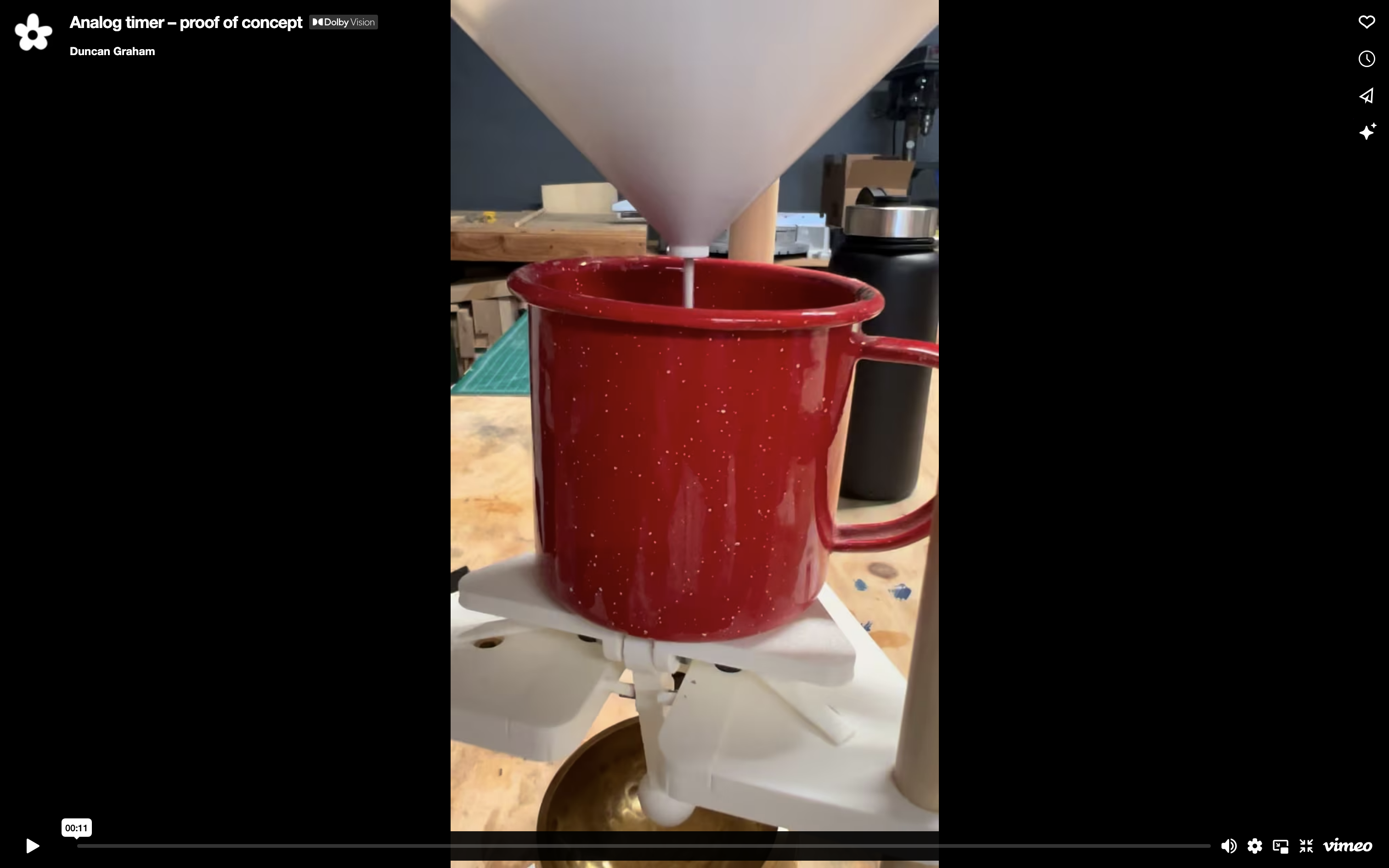
As promised in the last post, here's a video that shows the working prototype!
Here’s what we learned:
1. The adjustable aperture absolutely worked. Nice!
2. The loose, finely ground sand (well, technically, the “sand” in hourglasses is actually pulverized marble– the more you know!) but anyways it gets everywhere and makes an absolute mess.
On that last point, for weeks I’d figured that loose sand would be no problem at all. My hopeful logic went: It’s a meditation timer! Just be mindful when you’re pouring it!
Turns out, mindful pouring wasn’t enough. The more you used the timer, the more the sand would get everywhere. And because it was so finely ground, it was a bit like Pandora's box: once out of the box–so to speak– there was no good way to get it back in. Since we were using a fixed amount of sand, its diminishment over time caused a major problem: not only would you need to regularly clean up the spilled sand– you'd also have to regularly order more sand, just to make more messes! This was totally unworkable.
I explored designs that might contain the sand. But try as I might, I could find no path that felt promising. New challenges sprouted like weeds. How to design moving parts that wouldn't wear down due to friction from the sand? How would we determine when the sand had fully passed from the top to the bottom chamber?
During the same time, Kyle explored ferromagnetic sand– could we use magnets to control the flow speed? To determine the completed time-span? Experiments here did not inspire confidence. The magnets interrupted the flow of the sand in coarse, unpredictable ways, much less precise than the aperture method. We needed a bit more accuracy than magnets seemed to offer.
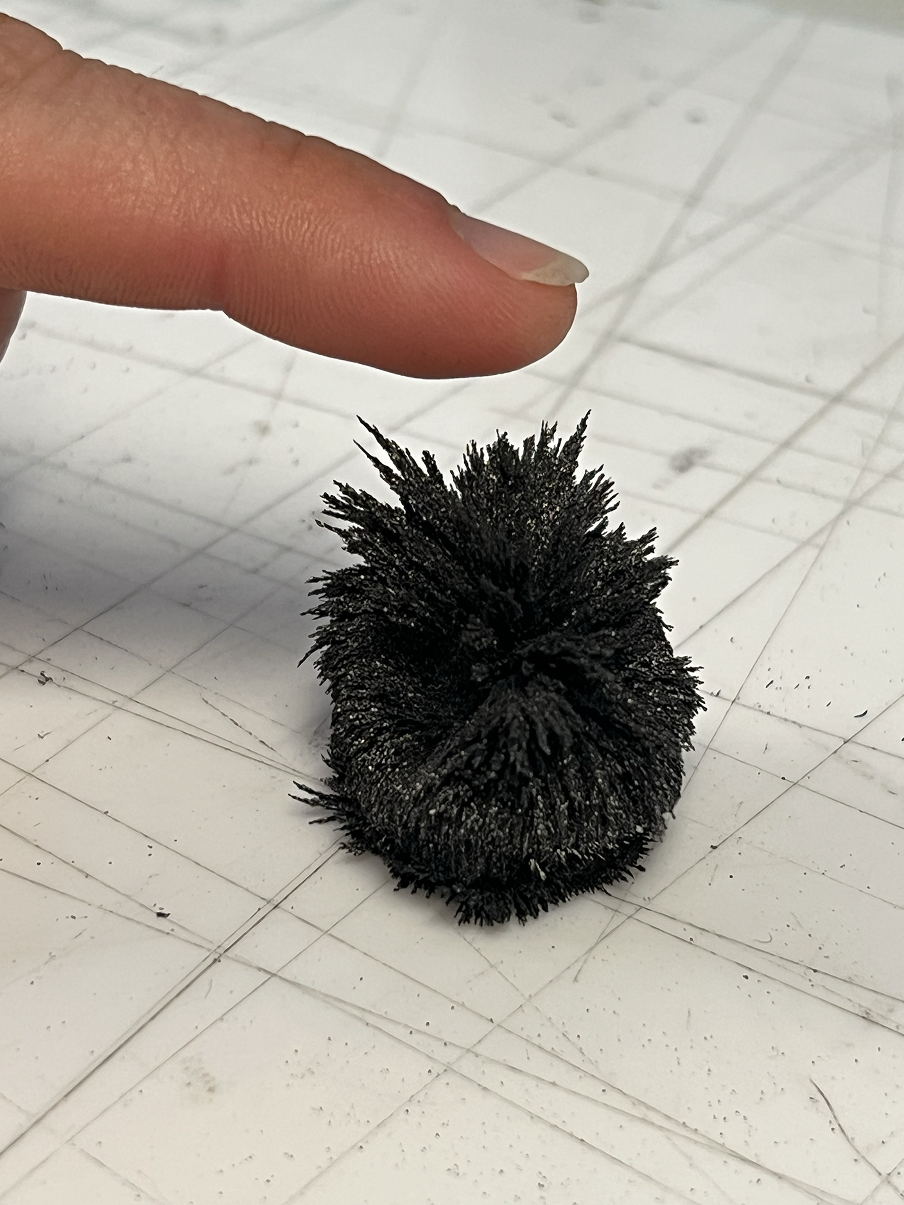
While the ferromagnetic sand didn't pan out, it was still fun to play with.
What's next
We gave sand our best effort. While it’s an area of exploration that’s certainly not been exhausted, we have enough evidence to move on to more promising possibilities. Concretely: we'll be looking into mechanical systems.
Huge thanks to Brandt and Kyle for running with me through this whole sand-filled adventure. Y'all turned sketches into reality and made the process a joy. Onward to the next lap!
✌️,
duncan
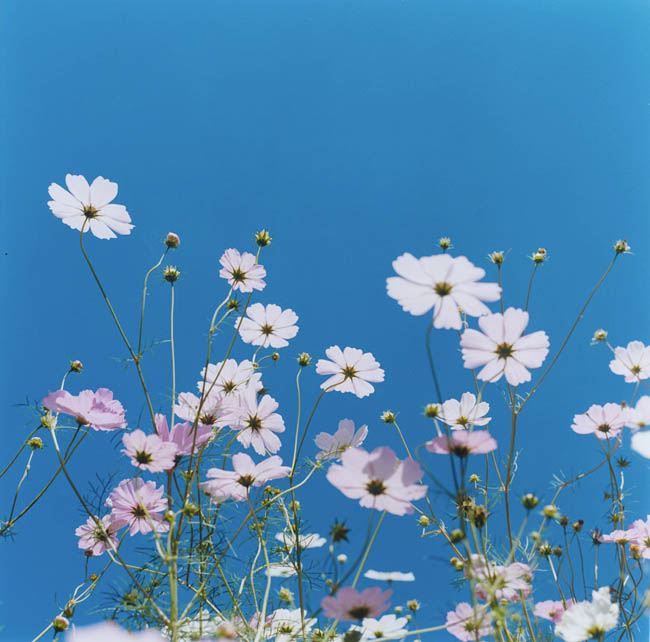
Get future updates in your inbox